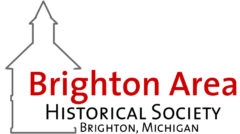March 10, 1871, C.T. Hyne sold land north of Franklin, south of Walnut, east of 7th and west of Ore Creek in Brighton Village to Hiram Smith and Edward and William McPherson, Jr. The portion north of Main Street had been originally purchased from the Federal government by Elizabeth Cushing May 8, 1835; that south of Main Street, by Elijah Fitch, July 29, 1836. There was, of course, no Main Street, merely the surveyors line between sections 30 and 31 of Brighton Township. (At that time still part of Green Oak Township.) However, a wagon trail soon did extend west from the Grand River Trail into Genoa Township.
Smith and the McPhersons were instrumental in the drive to promote the development of the Detroit, Lansing and Lake Michigan Railroad Company. Since 1837, the state had commissioned several railroad companies but none resulted in lines as far west as Livingston County. Several consolidations had taken place over the years until July 4, 1871, when a jubilant crowd greeted the first train through Brighton on its way west. As it happened the D.L. & L.M. tracks were located diagonally almost through the center of the newly purchased property.
Early in 1872, with much fanfare, flags waving, bands playing and banners flying the highly promoted opening of the Smith/McPherson Addition occurred. Statewide and national advertising always accompanied a new development. (One is reminded that todays developments are also well promoted.) Hundreds of residential and business lots were platted and sold. Lewis Dorr, Jacob and Henry Euler, Andrew and Lewis Pless, Henry Herbst and the Cooks were among the first purchasers. There were early settlers, whod retired, decided to live in town and take it easy, leaving the farm to their children. Some wanted to engage in a business endeavor in town. Two lots were often bought, a home built on one and a stable on the other. A few of these small barns are still in evidence. Room for a garden, chickens, fruit trees, etc., was also desired. At least ten homes were built within the next three years. Brick makers, masons, carpenters, well diggers, etc., were in high demand. In a shrewd move, lots were donated to the Weslyan Methodist Church at 4th/ Washington and to the Baptist Church at 2nd/ Madison; plus room for parsonages.
Grain elevators, lumber yards, livestock pens, a planing mill a depot and a hotel, the Western House, were built within a year or two. Blacksmith shops, general stores, hardware dealers, Lawsons (1871) bank, candy/cigar stores, butcher shops, bakeries, liveries, the Village Hall, professional offices and real estate (of course) offices, etc., were soon all in place east of the tracks. For some time the railroad tracks became the defining border between business and residential structures tho many business owners lived on the second floor of their establishments.
Compiled by Marieanna Bair from Bill Pless writings; 1880 History of Livingston County; the BAHS Historic Resource Survey; the 1867 Centennial History of Brighton.
